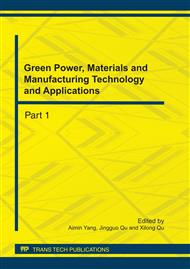[1]
CUNDALL P A. A computer model for simulating progressive large sc ale movements in blocky system [C] / / Muller Led. Proc Symp Int Soc Rock Mechanics. Rotterdam: Balkama AA, 1971, (1) : 8-12.
Google Scholar
[2]
THORNTON C. Interparticle sliding in the presence of adhesion. J Phys D: Appl Phys, 1991, 24: 1942-(1946).
DOI: 10.1088/0022-3727/24/11/007
Google Scholar
[3]
Johnson KL (English) with. Contact mechanics. Translated by Xu Bing industries. Beijing: Higher Education Press , 1992. 96-119.
Google Scholar
[4]
Mindlin RD, Deresiewicz H. Elastic apheres in contact under varying oblique forces. J Appl Mech, 1953, 20 (3) : 327-344.
DOI: 10.1115/1.4010702
Google Scholar
[5]
Johnson KL, Kendall K, Roberts A D. Surface Energy and the contact of elastic solids. Proc R Soc Lond A, 1971, 324: 301-313.
Google Scholar
[6]
Savkoor AR, Briggs GA D. The effect of tangential force on the contact of elastic solids in adhesion. Proc R Soc Lond A, 1971, 365: 103-114.
Google Scholar
[7]
Oda M, Iwashita K, Kakiuchi T. Importance of particle rotation in the mechanics of granular materials. In: Behringer RP, Jenkins JT, eds. Powder & Grain 97, 1997, 207-214.
Google Scholar
[8]
Kishino. Computer analysis of dissipation mechanism in granular media. In: Biarrez J, Gourves R, eds. Powders and Grains, Proc Int Conf Micromech Granular Media. Rotterdam: Balkema AA , 1989. 323-330.
Google Scholar
[9]
Lian G, Thornton C, Adams M J. A theoretical study of the liquid bridge forces between two rigid spherical bodies. Journal of Colloid and Interface Science , 1993, 161: 138-147.
DOI: 10.1006/jcis.1993.1452
Google Scholar
[10]
ALBERTO DI RENZO, FRANCESCO PAOLO DI MATIO. Comparison of contact-force models for the simulation of collisions in DEM - based granular flow codes [J]. Chemical Engineering Science, 2004, 59: 525-541.
DOI: 10.1016/j.ces.2003.09.037
Google Scholar
[11]
CLEARY P W. DEM simulation of industrial particle flows: case studies of dragline excavators, mixing in tumblers and centrifugal mills [J]. Powder Technology, 2000, 109: 83-10.
DOI: 10.1016/s0032-5910(99)00229-6
Google Scholar
[12]
ASMAR B N, et al. Validation tests on a distinct element model of vibrateing cohesive particle systems. Computer and Chemical Engineering, 2002, 26: 785-802.
DOI: 10.1016/s0098-1354(01)00772-4
Google Scholar
[13]
MISHRA B K, MEHEROTRA S P. Modelling of particle stratification in jigs by the discrete element method. Minerals Engineering, 1998, 11(6): 511-522.
DOI: 10.1016/s0892-6875(98)00033-8
Google Scholar


